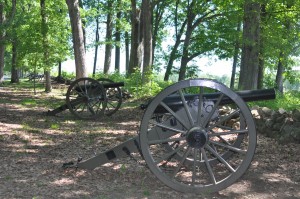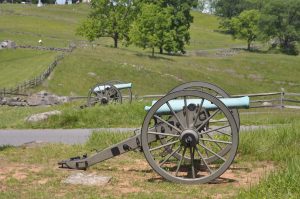KN, p. 56 “How many cannons at Gettysburg?”
If there are no paragraph separations in this article, please double-click on the title to create a more readable version.
Cannon located along the line of trees on Seminary Ridge.
Our trip to Gettysburg started with a stop at the Visitor’s Center where we picked up guide books and maps of the Gettysburg National Military Park. We decided to take the self-guided tour through the 6,000 acres of battlefields so that we could take plenty of photos and move at our own pace. Our plan was to follow the maps in order of the original battles 149 years ago. We had three days to get it done.
It’s tough not to be struck by the different terrain the soldiers had to deal with – gradual hills, wide fields cut with a few split rail fences, tree covered rocky outcroppings. It was sunny and hot during our drive, so weather conditions were pretty similar to that of the soldiers back then. Except we were wearing shorts, had on comfortable shoes, carried plenty of water, and we were traveling by car. The Union and Confederate soldiers were not as well equipped.
There were cannons everywhere. The guidebooks said that over 650 guns were hauled into the area by both horses and men. Much of the artillery seen on the hills today saw use during the Gettysburg campaigns.
There are a few reasons that cannons played a big role at Gettysburg:
*The constant, deafening level of noise was meant to demoralize the infantry waiting for orders to cross the open fields.
*Holding the high ground was easier with the cannons firing from close to a mile away, cutting down soldiers before they moved in on the hill.
*The large percentage of rifled guns meant that cannons could be fired with greater accuracy over a distance than the smoothbore cannons. That resulted in more damage to more men in the enemy camp with minimal risk to your own side.
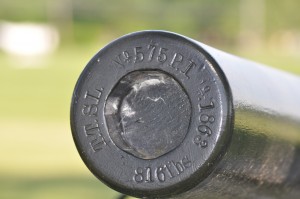 This is a cast iron rifled gun, stamped (starting clockwise at 12:00) with the serial number of the gun, the manufacturer, the year of production, the weight of the gun, and last, the inspector’s initials (9:00).
This is a cast iron rifled gun, stamped (starting clockwise at 12:00) with the serial number of the gun, the manufacturer, the year of production, the weight of the gun, and last, the inspector’s initials (9:00).
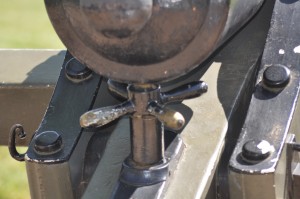 Rear view of cannon, showing knob used to adjust the angle of the cannon, which changes the range of the shot.
Rear view of cannon, showing knob used to adjust the angle of the cannon, which changes the range of the shot.
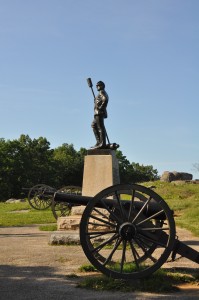 Statue in honor of men who fired and maintained the cannons, valuable pieces of equipment at Gettysburg.
Statue in honor of men who fired and maintained the cannons, valuable pieces of equipment at Gettysburg.
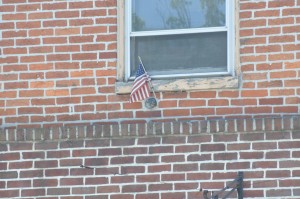 Downtown Gettysburg building. The small flag shows the location of a cannonball fired during one of the skirmishes through town.
Downtown Gettysburg building. The small flag shows the location of a cannonball fired during one of the skirmishes through town.
My dad (who served in the infantry in WW2) told me once that basic training included crawling under barbed wire during live ammo fire from either artillery or rifles firing across the fields in front of the soldiers. If you panicked and stood up, you were dead.
At Gettysburg, if a soldier had a grudge against a guy in his outfit, it would not have been that hard to shoot him in the back during one of the charges. Who would have bothered to check each body to see where the kill shot came from, when thousands of guys lay dead in the fields?
Field Cannons
*Source: Holt, Betsy. “Gettysburg National Military Park Museum and Visitor Center: Official Guidebook,” Nashville, Tennessee, Beckon Books, 2011.
*Source: Newton, George W. “Silent Sentinels: A Reference Guide to the Artillery at Gettysburg,” New York, NY, Savas Beatie LLC, 2005.
*Photos by Patti Phillips
KN, p. 56 “How many cannons at Gettysburg?” Read More »

